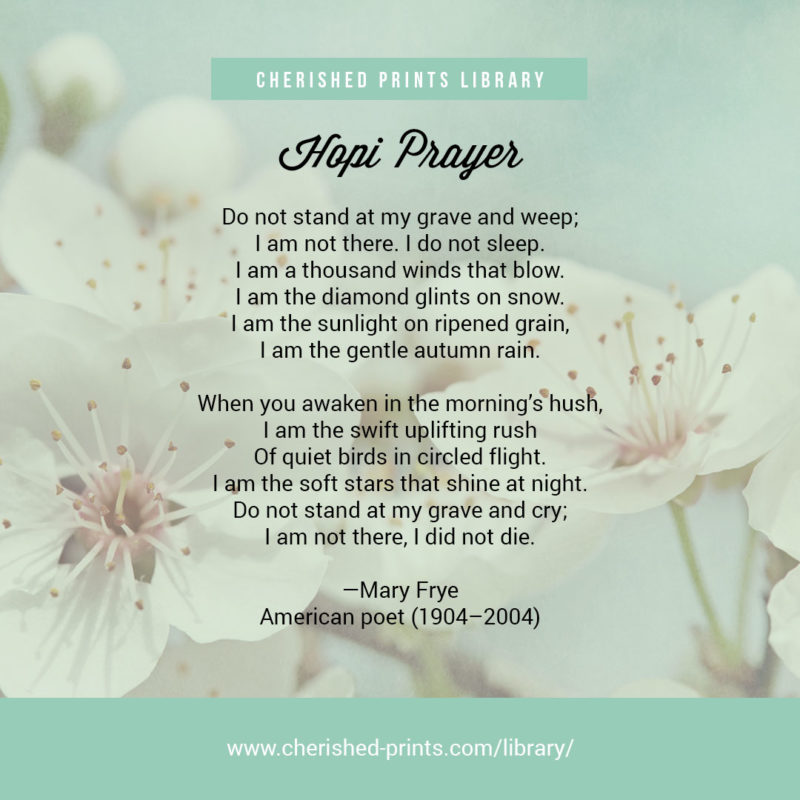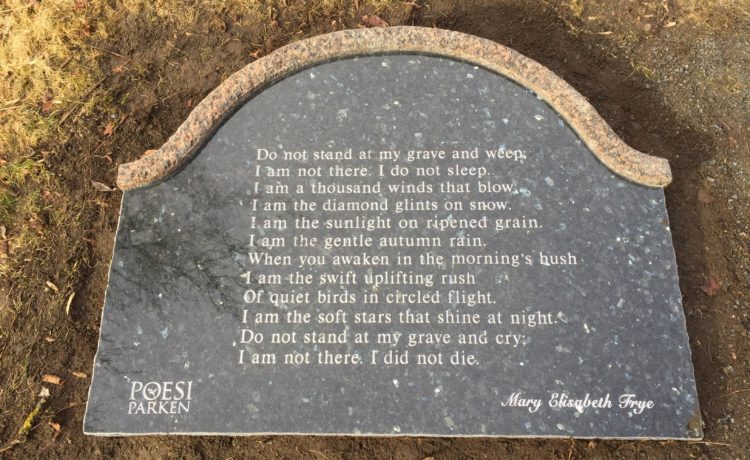Do not stand at my grave and weep I am not there. Let me know your thoughts.
 Hopi Prayer Do Not Stand At My Grave And Weep Cherished Prints
Hopi Prayer Do Not Stand At My Grave And Weep Cherished Prints
Without reference to the 1934 printing in The Gypsy Mary Frye.

Do not weep upon my grave. I am the sunlight on ripened grain. I am the thousand winds that blow I am the diamond glints on snow I am the sunlight on ripened grain I am the gentle autumn rain. Its composed of rhyming couplets in iambic tetrameter though a few lines have extra syllables breaking up the structure to give extra emphasis.
I hope you enjoy it as much as I do. Lucie Storrs has put together a collection that comes from the very being of the authors. She could be called an author of one poem.
The poem Do Not Stand at My Grave and Weep is a call to action in 12 lines. Debate surrounds the definitive and original wording of this. I do not sleep.
I do not sleep. Do not stand at my grave and weep I am not there I do not sleep. Do Not Stand At My Grave And Weep Over 250 funeral poems immediately is backed with a 60 Day No Questions Requested Cash Again Assure.
Do not stand at my grave and weep analysis Mary Elizabeth Frye was a unique author. I do not sleep. If within the first 60 days of receipt you are not satisfied with Wake Up Lean you can request a refund by sending an email to the address given inside the product and we will immediately refund your.
I am a thousand winds that blow I am the diamond glints on snow. In this book there is something for everyone regardless of faith or belief system you cannot help but find a poem or quotation that touches the heart. I do not sleep.
I am the soft stars that shine at night. To understand what the poem by Mary Elizabeth Frye means its best to go line by line. Mary Elizabeth Frye Mary Elizabeth Clark Featuring artist.
Although the origin of the poem was disputed until later in her life Mary Fryes authorship was confirmed in 1998 after research by Abigail Van Buren a newspaper columnist. Mary Fryes attributed famous inspirational poem prayer and bereavement verse. In fact an American housewife passionate florist and avid reader Mary Frye wrote several tenths of poems.
Do not stand at my grave and weep is the first line and popular title of a bereavement poem widely attributed to Mary Elizabeth Frye. I recently happened upon this poem by Mary Elizabeth Frye and I thought it was so beautiful. Do not stand at my grave and weep I am not there I do not sleep I am a thousand winds that blow I am the diamond glint on snow I am the sunlight.
If throughout the first 60 days of receipt you arent glad with Wake Up Lean you may request a refund by sending an e mail to the tackle given contained in the product and well instantly refund your complete buy worth with no questions requested. I happened to chance upon this poem a while ago when I was checking my email. Do Not Stand At My Grave And Weep Over 250 funeral poems instantly is backed with a 60 Day No Questions Asked Money Back Guarantee.
Do Not Stand at My Grave and Weep. Do not Stand at my Grave and Weep Romanian translation Artist. Of course the reason I am sharing this remarkable verse here is not to discuss who the original author is but to share with you the wisdom in the words.
I am the diamond glints on snow. Do not stand at my grave and weep Do not stand at my grave and weep is a poem written in 1932 by Mary Elizabeth Frye. When you awaken in the mornings hush I am the swift uplifting rush Of quiet birds in circled flight.
Bulgarian Catalan Chinese Bulgarian Catalan Chinese. I am a thousand winds that blow I am the diamond glints on snow I am the sun on ripened grain I am the gentle autumn rain. Its reached millions of people is commonly read at funerals and was requested over 30000 times by Brits to be included in a collection of Great Britains favorite poems.
Do Not Stand At My Grave And Weep Lyrics. I am a thousand winds that blow. I am the soft stars that shine at night.
What lovely comforting words to leave to the people she was to leaveshe left behind. On her death in 2004 The Times English Newspaper quoted a version of this poem in her autobiography. The Poem The poem has since been translated into at least a dozen languages set to music nearly 20 times and referenced numerous times in popular culture.
Do not stand at my grave and weep I am not there. When you awaken in the mornings hush I am the swift uplifting rush Of quiet birds in circled flight. When you waken in the mornings hush I am the swift uplifting rush Of gentle birds in circling flight I am the soft star that shines.
Originally titled Immortality the poem was written by Clare Harner Lyon 1909-1977 and first published over her maiden name Clare Harner in the December 1934 issue of The Gypsy poetry magazine. Do not stand at my grave and weep is a powerful first line of a poem that might be even more powerful too. Read by Tom OBedlam.
Do not stand at my grave and weep I am not there. Do not Stand at my Grave and Weep 32 translations Translations. While generally now attributed to Mary Frye the hugely popular bereavement poem Do not Stand at My Grave and Weep often shown as Dont Stand at My Grave and Weep has uncertain history and origins.
Do not stand at my grave and weep I am not there. Do Not Stand at My Grave and Weep is a poem largely considered to be written by Mary Elizabeth Frye 1904-2004 but of disputed origin. I am the gentle autumn rain.
Do Not Stand At My Grave And Weep is a book of beautiful writing about grief. However the mystery of the true origins of Do Not Stand At My Grave And Weep seems now to have been solved when the poem was categorically attributed to Mary Frye in 1998 following research by Abigail Van Buren aka Jeanne Phillips.